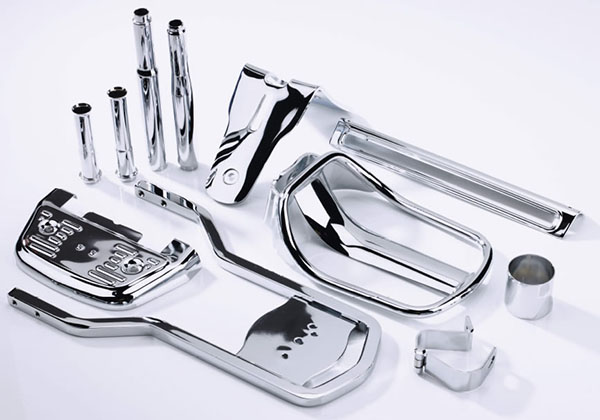Cosmetic Metal Stamping

Cosmetic Metal Stamping
Since 1947, Vulcan Industries has provided high volume cosmetic Class A decorative metal stampings and assemblies for some of America’s most successful and diverse original equipment manufacturers (OEMs). Our design and engineering team works with you throughout the design, quoting, production, assembly, inspection, packaging and shipping process to ensure that we meet your surface critical requirements.
What is Cosmetic Metal Stamping? An Overview:
A cosmetic metal stamping is a decorative component that can be functional or ornamental. These components can have many types of top-coat or finishes such as decorative chrome, powder coat, wet paint, polish or brushed. They can also be made from carbon, alloy and stainless materials.
Here are some examples:
• Functional cosmetic motorcycle stampings are back rests, accessory mounting brackets and luggage racks.
• Decorative motorcycle stampings are used to cover a vehicle’s less appealing areas, improving visual appeal or to create a personal customized look.
• Medical and dental uses of cosmetic stampings range from hand-held tools to office equipment.
• In the food service industry, cosmetic stampings can be found at buffets and serving tables as well as on warming trays and cookers.
• Automotive applications range from decorative interior trim pieces to functional exterior such as mirrors.
What Processes Are Used to Ensure Achievement of Surface Critical Requirements?
As a first step, drawing and model review-design input is given so a manufacturing process that will yield an agreed upon cosmetic requirement can be met.
Drawing and Design: Cosmetic zones are often defined using an A, B, C and D method. A being the high luster, near perfect surface followed by B & C to D which allows for “as manufactured” surface conditions but still has a bright or consistent finish. These surface requirements are then placed on a cosmetic zone drawing. Some examples would include the use of cross-hatching patterns placed over areas on the part drawing to indicate the surface finish that’s needed in the area they are covering.
Material Selection: Next, a suitable material is selected. Generally, designers and engineers have a suitable material selected based on chemical and material properties. However, when cosmetic surface requirements exist, selection must be given special consideration. ASTM specifications do detail substrate surface condition allowances, but great care must be taken in choosing the correct specification for both supplier and producer (Slitter and Mill). For formed parts requiring surface conditioning in their flat state, (prior to forming) metal finishing techniques must be understood. Understanding metal finishing and having measurable targets (Ra Max between processing steps) is critical to designing a process that will meet customer expectations.
Pre-Production: Cosmetic parts require special consideration for manufacturing equipment, processes and productivity rates. Material and part handling coupled with housekeeping needs change with cosmetic parts. The pace of productivity is set by the fastest way to produce these cosmetic parts while preserving their delicate surfaces. Handling, necessary process packaging and frequent surface condition checks must all be taken into consideration.
Tooling: Tool design and build also changes for cosmetic stampings. Since great care has been exercised in selecting the right material supplier, why damage part surfaces with inferior tooling? Stripper faces, where blocks split, material lifting, guiding and part ejection are now even more critical to success.
Staff Training: Employee training is pivotal. Having employees that truly understand cosmetic part requirements is necessary. This specialized workforce should be cross-trained, having the ability to set-up and stamp or assemble and pack finished cosmetic parts.
Packaging: This aspect should be given special attention. The use of cell or compartmental packaging is now necessary, but protective materials and their associated labor costs are often overlooked. Where cell or compartmental packing is not an option, placing parts in foam pouches, foam wrapping, use of layer pads or heavy poly bags will work. Special consideration should be given to cost and waste. Many times, returnable and reusable packaging are a worthwhile investment.